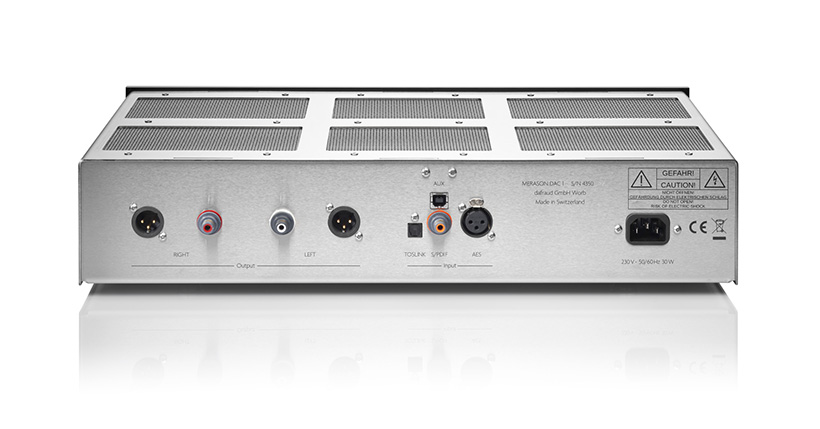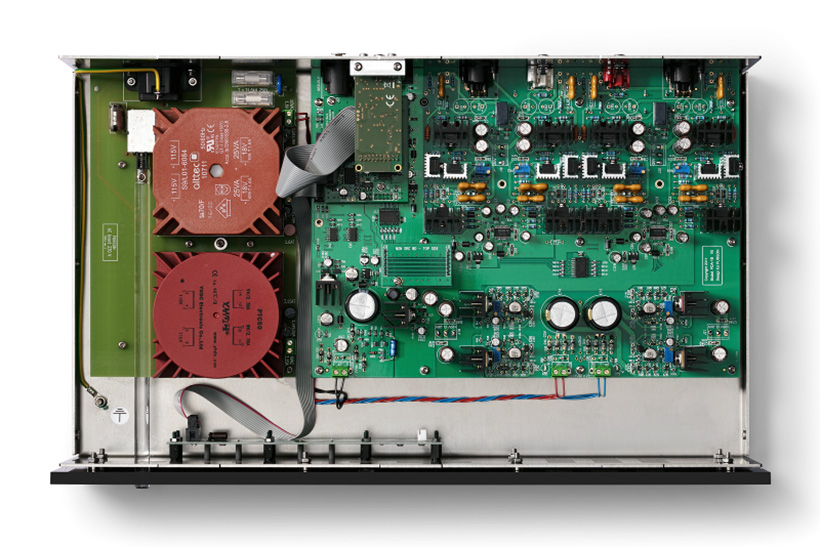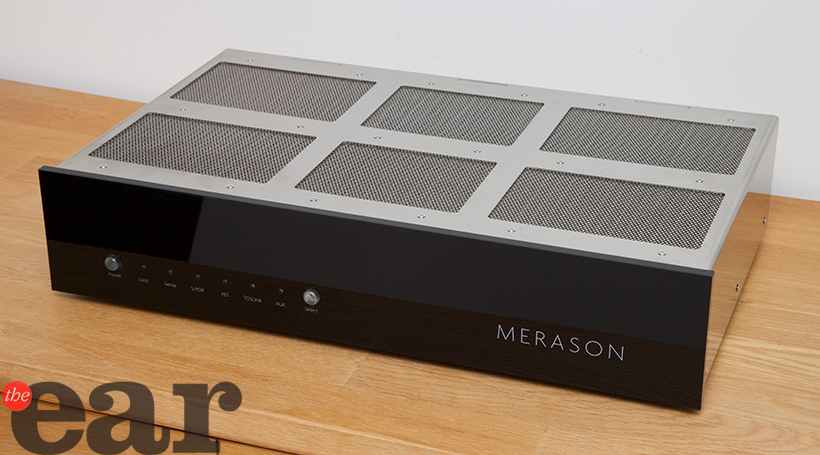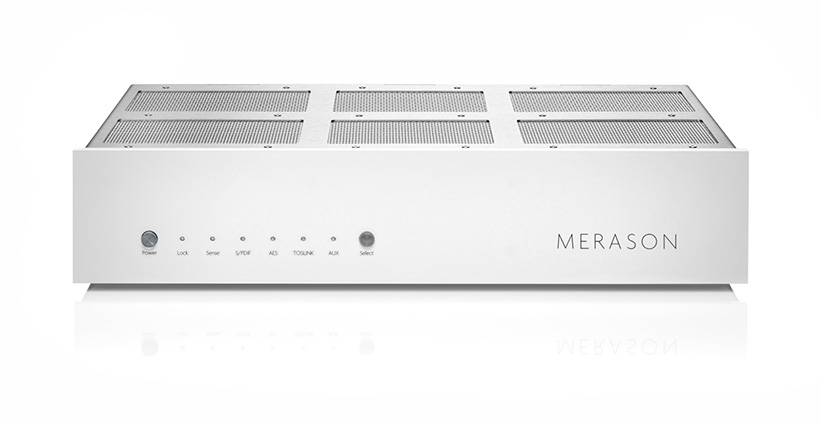Merason DAC1 digital to analogue converter
If you spotted the Merason DAC1 at the High End show in Munich you wouldn’t equate it with Swiss origin because high mass is clearly not a goal in its construction. It looks like something from France or the UK in its use of an acrylic front panel and relative thin, chrome nickel steel casework with no fancy OLED display. In other words the DAC1 looks like what it turns out to be, a purist dedicated D/A converter where the money has been spent on the inside where it counts.
There are none of the features such as volume control, sample rate display or wi-fi functionality found on many DACs, and in many respects it could have been created for the CD era. But look a little bit closer and ask a few questions of designer Daniel Frauchiger and you will discover that it’s a rather interesting DAC.

The DAC1 has the usual array of inputs including coax, optical, AES/EBU and USB with the latter marked ‘Aux’ on the front panel, and outputs on balanced and single ended connectors. The latter is explained by the fact that Daniel plans to offer the DAC1 with an I2S input in place of the USB, so the name covers both options. The RCA connectors are high quality WBT Nextgen types which is a luxury even at this price point. The front panel is pretty straightforward with lights to indicate source selected, USB signal detected and its ability to process the incoming signal.
This is because of the most purist spec on the machine which is its dedication to PCM up to a maximum of 192kHz, it won’t dally with higher sampling rates or DSD which is a radical proposition in this field. It’s a particularly hairshirt approach that I have only encountered in one other converter, CAD 1543 MkII which runs ancient Philips multibit chips. The Merason is a little more up to date in its choice of a BurrBrown 1794A chipset (one per channel), but that is hardly state of the art so what gives? It turns out that the 1794A uses a hybrid of multibit and delta-sigma technologies so has something in common with the TDA1543 but was chosen for the usual reason, the engineer thinks it sounds good.

Sound quality
The Merason DAC1 has a decidedly different sonic character to many digital to analogue converters, it’s more in line with DNM amplifiers of the nineties or Rega turntables today, products that share its unflinching attitude to transparency. There is a degree of tuning in any audio component be it a turntable, a speaker or a DAC, there are always component choices to be made that are about what the designer likes and what works in his or her system. Most go for a balance that has a degree of forgiving smoothness, one that will work with a variety of sources and systems and sound appealing with a range of music types. Merason takes a more black and white view and has voiced the DAC1 to be as revealing as possible and hang the consequences, whatever your source is producing that’s what you’ll hear. It’s an admirable approach and one that adheres to the highest principles of high fidelity, but also one that is going to meet with resistance from those who have gone large on digital sources that aren’t such good match.
I started out using the DAC1 with an Innuos Zenith SE server and Stack Audio Link II streaming bridge (and Link Linear PSU), its USB output connected to the ‘Aux’ input on the Merason. The result was thrilling speed and immediacy, a little on the bright side perhaps but very engaging indeed, it worked a treat with good recordings like Gil Scott-Heron’s I’m New Here which has a solo version of Home is Where the Hatred Is that has an electric presence with this degree of resolution. The power of the song is projected to tremendous effect, the lack of embellishment in the performance giving it extra pathos thanks to the clarity of voice and piano and the depth of feeling that Scott-Heron brings to it. Drummer Jeremy Cunningham’s The Weather Up There is a recent release with an equally sad subject but it’s played really well and the recording doesn’t get in the way, here the vitality of the piece is obvious as is the tautness of the percussive drive. The DAC1 reveals the natural reverb on the drums and places the other instruments and sounds in the soundstage in totally cohesive fashion.

Older recordings can also be great of course, I put on the Grateful Dead’s Cumberland Blues (Europe ’72) and was met with a very lively, up tempo rendition that was on the thin side but made sure that it was hard to sit still. Given that the Link II is not the most plush streamer in town I switched to the new Auralic Aries G2.1 that is due for review next month. This helped to bring out the sublime in everything played, revealing a weightless delicacy in the Merason that allows it to deliver fundamentals and harmonics with a speed that’s rare even among high end DACs. It remained very neutral and very revealing with no sense of time smear, trailing edges being really well defined and leaving no trace once the harmonic or reverberation had passed. This gives Keith Jarrett’s piano a tremendous delicacy when it’s called for and visceral realism when things get more lively. The tonal balance remained on the light side however and while this works beautifully with better recordings it can feel a bit uncomfortable with lesser ones, especially if played at volume, so I stuck to a few more of the better ones and revelled in the brilliance of Steely Dan’s Home at Last and the power of Nick Cave’s Jesus Alone.
Pondering the matter I recalled that with the similarly revealing Kii Three active speakers a Melco server proved the best match, on that occasion I had the top model but many years back I bought an N1A which is used largely for back-up, so I hooked that up to the Ansuz X-TC network switch (a genuinely remarkable device) and gave it a spin. This proved to be the perfect partner for the Aries G2.1 and Merason DAC1, its calmer and perceptibly darker balance working a treat with the all seeing converter. Now I had depth of image, high resolution, superb timing and a tonal balance that could be turned all the way up without any forwardness creeping in. I played a variety of pieces and found low level detail on all of them that had been hidden with the earlier set up, it meant that different recordings were as diverse in character as you would expect given the variations of age, recording medium, mixing desk, producers and musicians that exist. It proved that there is just as much need to balance components with digital as there is with analogue sources, the server, streamer and DAC being equivalent to the turntable, arm, cartridge and phono stage of a vinyl replay system in broad terms. Get the right ones together and you have a system that really sings, and as ever the first part, the source, is the most important part of the chain.

Under these circumstances the intoxicating immediacy of the Merason can be quite addictive, it does what few digital components do, strips away the polish and lets you hear the real meat of the music. Talk Talk’s Myrrhman has a mesmerising intensity that’s created with immense restraint and poise, you can’t hear the days and nights of studio time it took to make but you do feel a nervous energy that few converters bring home. The muscularity and depth of the bass is pretty gorgeous too. Steve Pearce is the guru in Bowers & Wilkins research dept, he used to bring some pretty intense music over to demonstrate their bigger products in the days when engineers were allowed to meet the press. One such track is Gun by Scout Niblett, a track with so much palpable tension in it that it’s positively visceral when played on a converter that’s as revealing as this one. I will have to dig out a few more of Steve’s test tracks.
The Merason DAC1’s antithesis to DSD is the only reason I can see why anyone who’s seeking genuine high fidelity would not want to have it in their system, but it’s worth remembering that most streamers can convert DSD to PCM and that very few great records were originally captured in DSD. If you are looking to cut through the veneer and hear as much of what was put down in the studio as a converter anywhere near this price will allow should, brace yourself for a genuinely intense musical experience.


